Table of Contents
*
Featured Inuit Dog Owner: Ken MacRury, Part 1
*
Remembering Niya
*
Page from the Behaviour Notebook: Bishop and Tunaq
*
Antarctic Vignettes
*
On Managing ISD Aggression
*
The Qitdlarssuaq Chronicles, Part 3
*
News Briefs:
Inuit Dog Thesis Back in Print
Nunavut Quest 2003 Report
Article in Mushing Magazine
Possible Smithsonian Magazine Story
*
Product Review: Dismutase
*
Tip for the Trail: Insect Repellents
*
Book Review: The New Guide to Breeding
Old Fashioned Working Dogs
*
Video Review: Stonington Island, Antarctica 1957-58
*
IMHO: The Slippery Slope
Navigating This
Site
Index of articles by subject
Index
of back issues by volume number
Search The
Fan Hitch
Articles
to download and print
Ordering
Ken MacRury's Thesis
Our
comprehensive list of resources
Talk
to The
Fan Hitch
The Fan
Hitch home page
ISDI
home page
Editor: Sue Hamilton
Webmaster: Mark Hamilton
Contents of The Fan Hitch Website and its publications are protected by international copyright laws. No photo, drawing or text may be reproduced in any form without written consent. Webmasters please note: written consent is necessary before linking this site to yours! Please forward requests to Sue Hamilton, 55 Town Line Rd., Harwinton, Connecticut 06791, USA or mail@thefanhitch.org
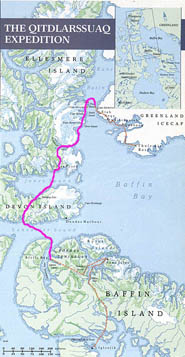
The Qitdlarssuaq Chronicles, Part 3
by Renee Wissink
Even in Qitdlarssuaq's time, Lancaster Sound had a nasty reputation. Winter travellers from Baffin Island to Devon Island had the choice of detouring far to the west to find solid ice or taking their chances at traversing a mass of moving, grinding and overriding ice pans propelled by a number of contradictory currents. Although we had been warned that we would arrive too late to cross Lancaster Sound safely, Inuit elders had told us that there is a period in April when the ice movement ceases, and we were elated to discover that the sound was solidly frozen.
Frozen, however, did not mean easy to cross. The slabs of moving ice had formed a chaotic jumble of hummocks and 50-foot-high (15 m) pressure ridges. Our job was to find a route through the maze, and as I remarked to Beedell, "Trying to ram a 20-foot sled through a six-foot hole just doesn't work." Time after time, we were forced to take our axes and simply chop our way through, and even at that, the sleds would become so thoroughly wedged that it took all of us working on one sled up to an hour just to get it moving again. We weaved in and out; we laboured up and over; we chopped and we sweat and we swore. The work was brutal, and what minimal progress we did make seemed to be largely circular, Beedell suggested that our journey had become more one of rupture than rapture - a claim well supported by our rapidly proliferating assortment of bruises, sprains and lacerations.
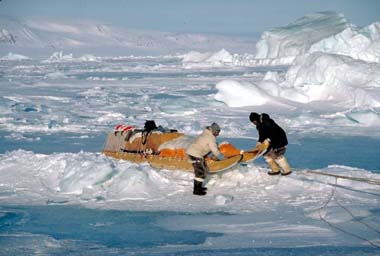
Crossing leads and rough
ice
Nunavut
Tourism photo
Adding to the general paranoia of the crossing was the knowledge that Lancaster Sound is haven for some 2,000 bears, one-eighth of the Canadian total. We crossed many sets of tracks daily, and the dogs sensed the bears' presence. We moved always with the fear that a bear could be just across the next pressure ridge and we knew it was only a matter of time before we ran into one. Since a bear will always approach downwind we placed our camps in the lee of large ice ridges and chained the best bear dogs in a semicircle below the tents. The rest of the dogs roamed free.
It was not, however until our fifth day on Lancaster Sound that we had our first encounter. I had gone to bed with a strong intuition that a bear would come during the night and when I was awakened at 6:30 a m. by a strange howling from the dogs, I knew what it was. Just beyond the dog line stood a young bear, a white apparition swaying slowly back and forth in the blowing snow of a ground blizzard, gazing toward the tents in what appeared to be a contemplative manner. The dogs were facing it, riveted in their attention, their backs to the wind and their long neck ruffs flowing forward. The bear made a move to advance between the dogs, but as if on cue, the loose dogs rushed it and drove it back. The bear paused, then advanced again but this time it was met with a stronger argument. Ikummaq had taken up our polar bear gun - a 12 gauge pump-action shotgun loaded with rubber slugs - and backed by rifles filled with deadlier ammunition, he fired two shots. The second slug hit the bear, and it bolted. It did not return.
Lancaster Sound yielded reluctantly - 95 miles (153 km) in 5 1/2 days. The last half-mile was particularly hellish, and I was amazed that we emerged with our limbs intact. At one point, as I was pulling the sled, it jolted violently to one side, knocking me down. Jammed against an ice wall, I had no room to maneuver and watched in horror as the 750-pound (340 kg) sled lurched forward over my legs. Beedell leapt past me screaming at the dogs to stop and grabbing for the brake, but in that moment, I realized I was alright. My legs had miraculously found a small patch of soft snow between two bulges of ice, and the sled slipped across without damaging them. I jumped up and raced for the sled smiling at Beadlell's incredulous look. "Hardly felt a thing," I said.
The bears were almost as troublesome as the ice. One came to within 300 feet (90 m) of us while we broke for tea one day, and it sat sniffing the air for the duration of the break. Another received an education of sorts as it wandered into camp when all the dogs were loose. Apak and Ikummaq had to track seven of the dogs to a site 15 miles (24 km) away where they were holding the exhausted bear at bay.
Crossing Devon Island opened our eyes to just how meagre life can be in the high Arctic. Over large areas, the land was devoid of anything more than sparse patches of lichen, and a few Arctic hares grazing among the rocks comprised our total faunal count. We found it difficult to believe that in other places on the island, small thermal oases nurtured lush vegetation and herds of musk ox. It was beautiful in its starkness, though, and we took a full day to descend a long river valley leading to Jones Sound. The valley walls rose hundreds of feet and were punctuated by isolated pillars of rock, remnants of once loftier mountains ravaged by time, wind, water and frost.
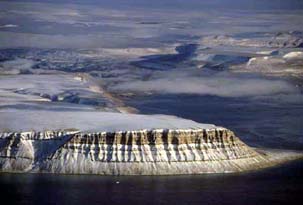
Devon
Island
Corel
photo
Qitdlarssuaq and his people appear to have spent some eight years on Devon Island, and there is good evidence that they had at least one great party during their stay. In 1853, Qitdlarssuaq encountered Commander Inglefield of the British Navy supply ship Phoenix, who was in the Arctic to stock a supply cache near Dundas Harbour. When Inglefield returned the following summer, he found that the cache - consisting in large pan of salted meal, flour and 25 barrels of rum - had been ransacked. The meat and the flour had been scattered (the Inuit would have found both largely unpalatable), but the rum had disappeared without a trace.
Another chance encounter with a European, in 1858, was pivotal in the emigrants' long journey north. Qitdlarssuaq met Francis McClintock (the famous English explorer then involved in the search for Sir John Franklin) at Cape Horsburgh in July of that year, and evidently, McClintock told him through an interpreter that he had met other Inuit in Greenland, far to the north and east. Shortly thereafter, Qitdlarssuaq began to move north again, in what was the most determined effort of the migration: four years later, in 1862, the Baffin Islanders made contact with Greenland's Polar Eskimos. As someone interested in at least maintaining his power base, Qitdlarssuaq likely did not mention to his followers his meeting with McClintock. Spirits, no doubt, would have come to him in a dream, telling of the Polar Eskimos and how to find them. As Father Mary-Rousselière has said, Qitdlarssuaq, outside his own time and culture, might be regarded as a man "little encumbered by scruples."
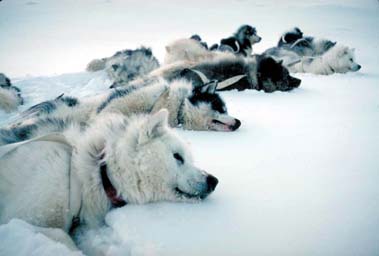
Team at
rest
Nunavut
Tourism photo
By the time we reached Jones Sound, we were experiencing 24 hours of daylight, which was actually less of a treat than might be imagined. Despite the light, the temperatures fluctuated dramatically between the daytime and nighttime hours - in some cases from 23 degrees F (-5ºC) to minus 40 degrees - and we decided to start travelling through the night both to avoid overheating the dogs and to take advantage of the firmer snow. The light, the temperature changes and the new travel arrangements played havoc with our bio-rhythms, and the performance of our bowels became a major topic of conversation. Time began to blur, and days muddled together. At one camp, we argued as to whether the present time was a.m. or p.m. We concluded that the answer was irrelevant. Out on the land in the Arctic spring, who cares?
After a 17-hour crossing of Jones Sound, during which we took turns skiing to quicken the pace, we arrived happy but exhausted in Grise Fiord, on Ellesmere Island. The Inuit team members were temporarily shocked out of their fatigue, however, to be greeted by people speaking a Quebec dialect of Inuktitut. As we soon learned, though - in a tale that ranks with the World War II internment of Japanese Canadians as a blemish on our reputation as humanitarian nation - there was good reason.
In the early 1950s, the federal government, for a variety of reasons, decided it should establish a resi-dent population on Ellesmere Island. Accordingly, several families from Port Harrison, Quebec, and Pond Inlet were uprooted and moved to a site near that of today's Grise Fiord. The elders, particularly those from Port Harrison, still spoke of the difficulties of their first winter, abandoned on a strange shore with only tents covered with donated buffalo skins as shelter. It was colder and darker than anything they had known, and many of them despaired of ever making it through that first endless Arctic night.
On the evening of May 2, we left on the final leg of our journey. It was an anxious departure, for we had heard that the ice was bad along the east coast of Ellesmere Island - our intended route. A Japanese adventurer attempting to walk from Resolute to Qaanaaq had gone through the ice twice near Pim Island and had to be airlifted out. How could we hope to pass with our heavy sleds where a lone man had broken through?
My foreboding was not helped much by the knowledge that our first goal on the last leg was a small lake at the head of Makinson Inlet, a place the Inuit call Perdlerarvigssuaq, "the place of great famine." By the time Qitdlarssuaq reached Greenland, he was growing old, and in 1870, after only six years with the Polar Eskimos, he decided that he wanted to return to central Baffin Island to die. Once again gathering together his people - or what remained of them - he started back across Smith Sound. They had travelled only as far as Cape Herschel, however, when Qitdlarssuaq was stricken by severe abdominal pains and died - the vengeance, his followers believed, of a Greenlandic shaman who Qitdlarssuaq had murdered, albeit at the request of the shaman's people. The rest of the small troop laboured to Makinson Inlet, where they were caught unprepared by the advancing winter. Many starved, and others reverted to murder and cannibalism.
It was natural, then, that we felt the place an eerie one, particularly after we discovered the remains of several old sod-and-whalebone houses. They might have belonged to some other inhabitants of Ellesmere Island whose settlement pattern is poorly known, but they might just as well have been the remains of the Baffin Islanders' great tragedy. Only five survived that winter, and they returned to Greenland, never to attempt the journey home again.
At the mouth of Makinson Inlet, we entered Baffin Bay, and although Qaanaaq was now almost directly east of us, we turned north to skirt what the old whalers knew as the North Water - the part of Baffin Bay and Smith Sound that stays open by virtue of its strong currents. The east coast of Ellesmere Island was beautiful but daunting: a tremendous ice-cap interrupted only by a few rocky bluffs and capes. Legions of calved icebergs, frozen solid in the sea ice, extended as far as we could see. At times, the bears seemed nearly as numerous as the icebergs, but they were well fed on seal pups and ignored our passing.
We, too, began to use the seals. To lighten our load and quicken the pace, we had carried only minimal seal meat dog food out of Grise Fiord, and once on Baffin Bay, we began to hunt. We knew that in early May, the seals enlarge their breathing holes and haul themselves out on the ice where they take a series of short, sunny naps, lifting their heads every few minutes to check for danger. While the seals napped, the hunters would walk quietly toward them and then crouch down behind a white hunting screen when the seals lifted their heads. The process was relaxed until the hunters were within shooting range. Anything but a clean head-shot would cause the seals to roll into their holes and disappear
Despite the predictions of bad ice, we found travel easy, and by the time we hit Orne Island, the excitement of potential success had begun to bloom. We were also feeling close to the emigrants, for the small island had been a pivotal landmark in both the outward journey and the attempted return. Orne was the most abundant hunting ground. Along the coast, a site rich in walrus, seal, polar bear and fox, and Qitdlarssuaq must have found it a veritable smorgasbord. Without it, the migration might not have succeeded.
Orne, as it turned out, was a cruel setup, for beyond we found three headlands - Cape Dunsterville, Cape Isabella and Cape Herschel - that extended directly into the open water of Smith Sound, and we were forced to travel overland across glaciers. Even then, although the work was back-breaking, the crossing of both Cope Dunsterville and Cape Isabella was accomplished without mishap. From the top of Cape Isabella, though, we knew we were in trouble: for as far as we could see, right to the Greenland coast, there was not a speck of sea ice. Polar bears, crevasses, intense cold, horrendous winds and starving dogs we could handle; open water we could not. We would have to travel farther north yet, and we knew each mile would be hard-won.
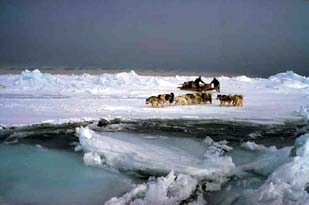
A formidable
challenge
Corel
photo
Dropping off the glacier to approach Cape Herschel, we found even the bit of ice right along the shore in terrible shape. Most of it was treacherously thin and crisscrossed by open leads, and we advanced nervously, zigzagging along pans of multi-year ice and developing expertise at yet another sledding technique - lead crossing. After searching out leads that we could jump over, we had to convince the dogs that they would enjoy a bracing dip in the Arctic waters (more often than not "encouraging" them by means of a collar-and-tail toss). And then, after they had scrambled upon the far side, we had to get them to pull like demons so that the sled would hit the lead with enough momentum to carry at least the bow across. It was wet, uncomfortable and harrowing work.
It was also in vain. Half a mile from Cape Herschel, we reached a stretch of open water that ran right up to the tongue of the Alfred Newton Glacier. Only wings would help us over it. We would have to backtrack, fighting our way over the bad ice and open leads once again, and then try to find a route onto and through what appeared to be an impassable glacier. It was a thoroughly depressing realization, and it took some time for us to regroup enough to start back. I was close to crying, and I saw tears of frustration in Apak's eyes. Qitdlarssuaq, we knew was buried some place nearby, and it was not difficult to imagine his spirit warding us off, mocking us for our belief that we could follow where he had gone. Some people claim his burial cairn can still be found on Cape Herschel, but I, for one, did not particularly want to find it. A grave would confer mortality, and I had come to view him as do the Canadian and Greenland Inuit - as a mythical figure, larger than life.
It took several hours to retrace our steps and another two days to thread our way through the horrors of the crevasse field. Only then, from the 3,000 foot (900 m) level, could we see in what position our gamble had left us. It was, in short, as beautiful a sight as any of us had dared hope for: a smooth, unbroken field of snow descending to a solid sheet of ice stretching out toward Greenland. Beedell whooped, reached for his skis and led off in a downhill rush. Even with chains and climbing ropes twisted around the runners to help brake the sleds' speed, we were at the coast within two hours.
Now, suddenly, luck fostered further luck: as we moved
north on the
ice, Apak spotted a seal and promptly killed it. We all
ate some of the
fresh meat, and then, with a huge smile Apak looked up at
Beedell and said,
"Mike, this is for all the hard times we've had." With
that, he cracked
open the seal's skull with his knife and swallowed a huge
chunk of the
steaming brain. Beedell paled but gamely rose to the
invitation and tried
a little piece. It was, he later told me "culturally
difficult but ultimately
rewarding - I'd eat it again." The dogs gorged
themselves; the seal
was their first meat in four long days.
…to be concluded